| DESCRIPTION | HISTORY |
Please Click On Any Picture for a Larger Version
 The rectangular case contains the microscope and a variety of items for preparing specimens and making slides. The case measures about 17 cm X 17 cm X 25 1/2 cm. It weighs about 8 pounds (3.6 Kg) all packed. There is a swing latch and a barrel key lock. The microscope stands on a large solid mahogany baseboard. At the front of the baseboard is an inclined ledge to take a 3 x 1 inch slide with a centering target. The baseboard also has cutouts to hold each of the three simple lenses. The microscope is permanently attached at the rear via its A-frame rear foot of black finish, on a hinge. An oval signature plate is attached at the rear of the baseboard and is signed: 'FIELD & Co, SUFFOLK ST, BIRMINGHAM.' This address was used by Field from 1852 onward. The third toe of the tripod is the tailpiece of the microscope and at its distal end is a small pointed pin to register on a choice of three holes in a brass plate in the center of the baseboard. The stage, main brass stage insert, and arm have a lacquered brass 'frosted'1 finish. The microscope is upright when the pin registers on the rearmost hole, and inclined at about 45 degrees when registered on the front hole. One additional position sits between the other two. A gimbaled mirror rides on a sleeve up and down the tailpiece. The microscope has a bar-limb construction with rack and pinion focusing. The main stage has one hole on each front corner to accept the stage-mounted bullseye or the stage forceps. A third hole is for the slide ringing table. The cutout in the stage measures about 81.5 X 58 mm. The compound tube is finished in lacquered brass. Unusually, its outer tube is a drawtube. There is one eyepiece and a single 3 part divisible objective fitting it. The three divisible parts of the objective are engraved 1,2, and 3. The arm can swing out of the way at will or be secured by tightening the knob.
The rectangular case contains the microscope and a variety of items for preparing specimens and making slides. The case measures about 17 cm X 17 cm X 25 1/2 cm. It weighs about 8 pounds (3.6 Kg) all packed. There is a swing latch and a barrel key lock. The microscope stands on a large solid mahogany baseboard. At the front of the baseboard is an inclined ledge to take a 3 x 1 inch slide with a centering target. The baseboard also has cutouts to hold each of the three simple lenses. The microscope is permanently attached at the rear via its A-frame rear foot of black finish, on a hinge. An oval signature plate is attached at the rear of the baseboard and is signed: 'FIELD & Co, SUFFOLK ST, BIRMINGHAM.' This address was used by Field from 1852 onward. The third toe of the tripod is the tailpiece of the microscope and at its distal end is a small pointed pin to register on a choice of three holes in a brass plate in the center of the baseboard. The stage, main brass stage insert, and arm have a lacquered brass 'frosted'1 finish. The microscope is upright when the pin registers on the rearmost hole, and inclined at about 45 degrees when registered on the front hole. One additional position sits between the other two. A gimbaled mirror rides on a sleeve up and down the tailpiece. The microscope has a bar-limb construction with rack and pinion focusing. The main stage has one hole on each front corner to accept the stage-mounted bullseye or the stage forceps. A third hole is for the slide ringing table. The cutout in the stage measures about 81.5 X 58 mm. The compound tube is finished in lacquered brass. Unusually, its outer tube is a drawtube. There is one eyepiece and a single 3 part divisible objective fitting it. The three divisible parts of the objective are engraved 1,2, and 3. The arm can swing out of the way at will or be secured by tightening the knob. 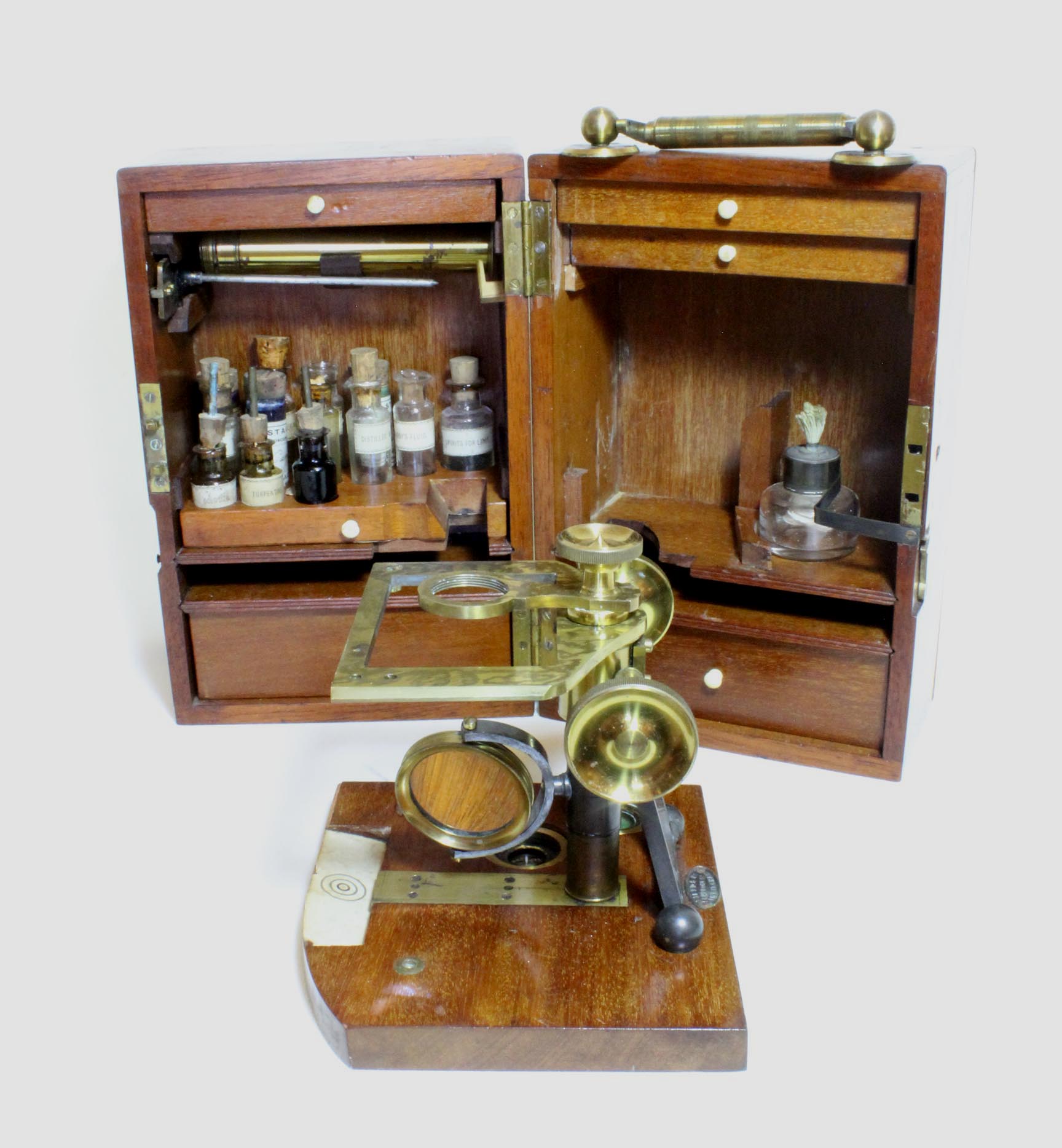
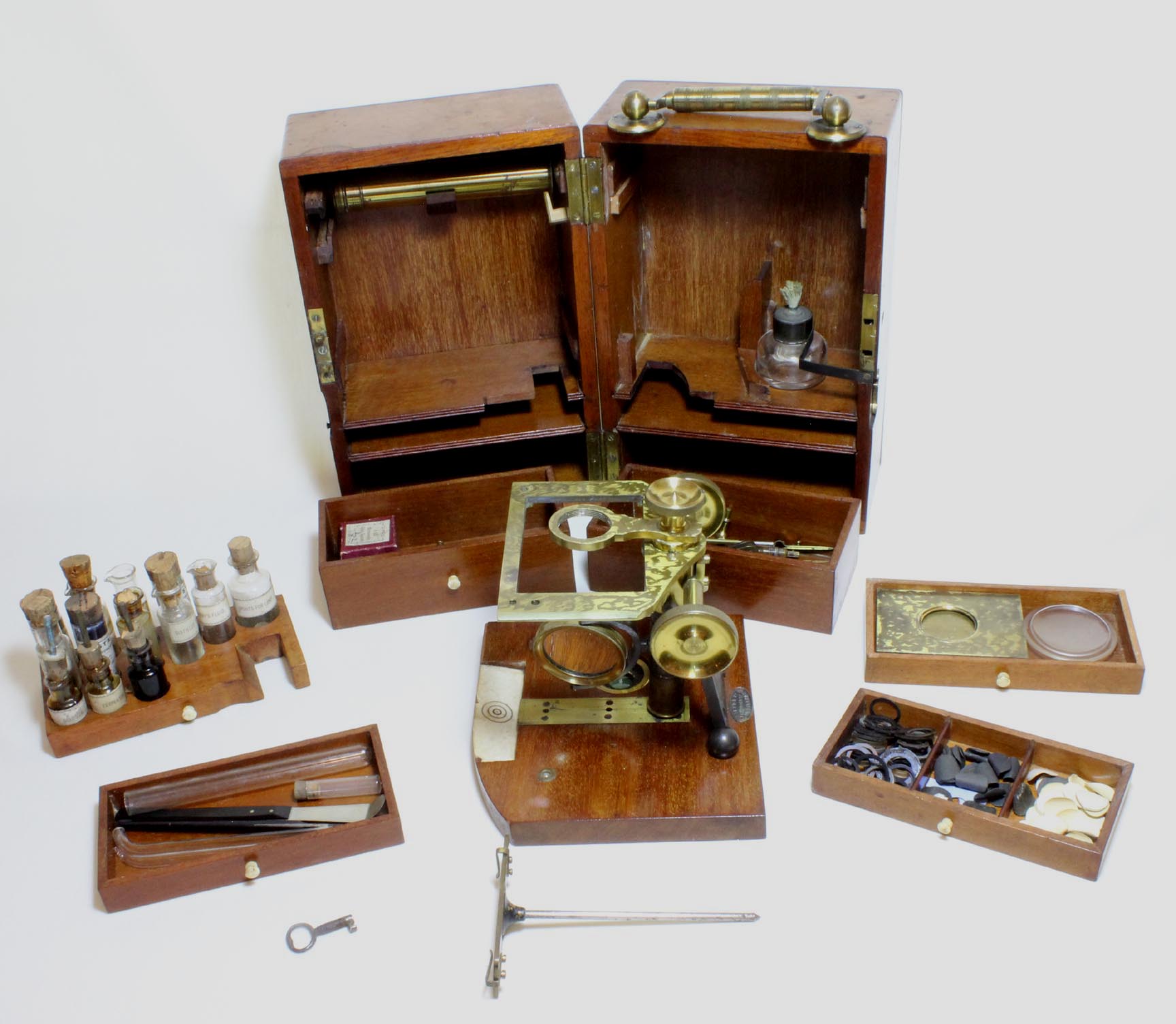 The drawers and other fittings contain many accessories, most are original. These include accessories in the drawers, the compound tube, and the alcohol lamp. The lamp is housed in a compartment on the right side, held in place by a spring stay. The compound tube rests on a ledge under the left upper drawer. The drawer holds it in place, and must be removed in order to extract the tube from the case. The ringing table sits in a slot in front of and just below the compound tube. The other accessories are housed in the drawers. Chemicals are housed in a removeable tray.
The drawers and other fittings contain many accessories, most are original. These include accessories in the drawers, the compound tube, and the alcohol lamp. The lamp is housed in a compartment on the right side, held in place by a spring stay. The compound tube rests on a ledge under the left upper drawer. The drawer holds it in place, and must be removed in order to extract the tube from the case. The ringing table sits in a slot in front of and just below the compound tube. The other accessories are housed in the drawers. Chemicals are housed in a removeable tray.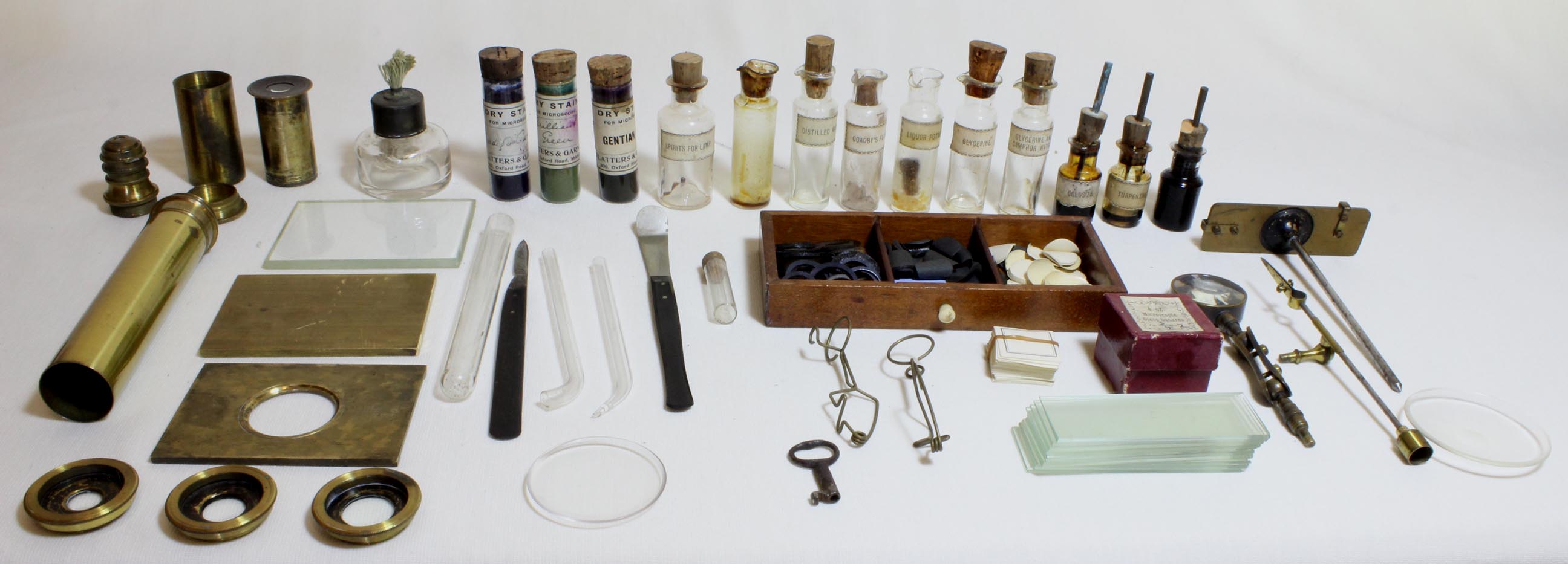
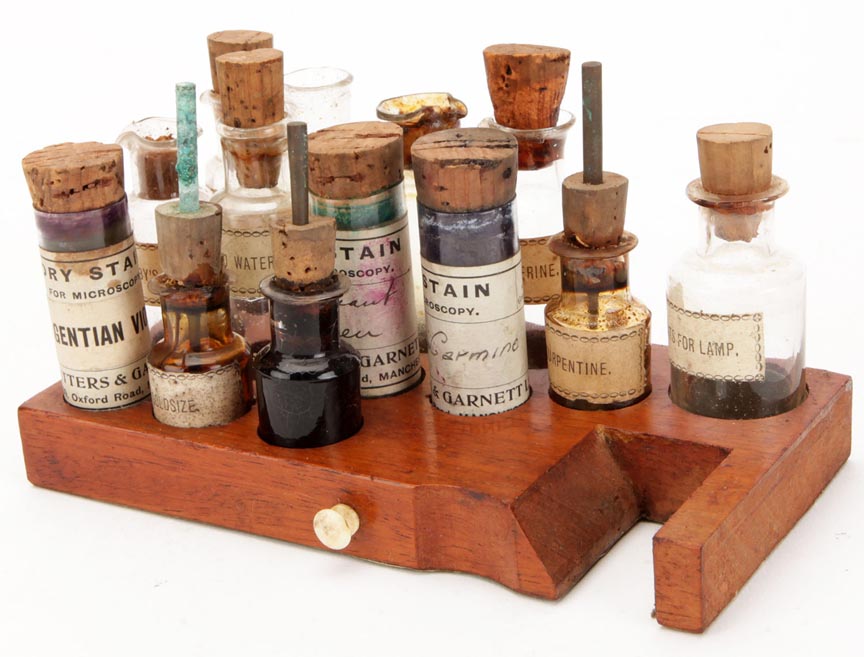
 A pull-out tray contains thirteen bottles of chemicals and stains, including turpentine and a bottle of alcohol for refilling the alcohol lamp. Three of these have brushes integrated into their cork lids, just as described in the original publication. The other bottles are for 'Goadby's fluid', 'distilled water', 'Goldsize', 'Glycerin', and 'Liquoir Potassae'. All these aforementioned bear labels that show they are original to the kit. Also included are three bottles of 'Dry Stain' by Flatters and Garnet including Gentian Violet, Brilliant Green, and Indigo Carmine, all with their contents intact. These types of stain preparations were not sold until late in the ninteenth century and are early twentieth century additions. The address for Flatters and Garnett on the bottles is 309 Oxford Road, Manchester dates from 1912. Three bottles have lost their labels, but one appears to be the original asphalte-varnish bottle; the turpentine, asphalte-varnish and goldsize bottles all have brushes integrated into their corks, just as described originally.
A pull-out tray contains thirteen bottles of chemicals and stains, including turpentine and a bottle of alcohol for refilling the alcohol lamp. Three of these have brushes integrated into their cork lids, just as described in the original publication. The other bottles are for 'Goadby's fluid', 'distilled water', 'Goldsize', 'Glycerin', and 'Liquoir Potassae'. All these aforementioned bear labels that show they are original to the kit. Also included are three bottles of 'Dry Stain' by Flatters and Garnet including Gentian Violet, Brilliant Green, and Indigo Carmine, all with their contents intact. These types of stain preparations were not sold until late in the ninteenth century and are early twentieth century additions. The address for Flatters and Garnett on the bottles is 309 Oxford Road, Manchester dates from 1912. Three bottles have lost their labels, but one appears to be the original asphalte-varnish bottle; the turpentine, asphalte-varnish and goldsize bottles all have brushes integrated into their corks, just as described originally. 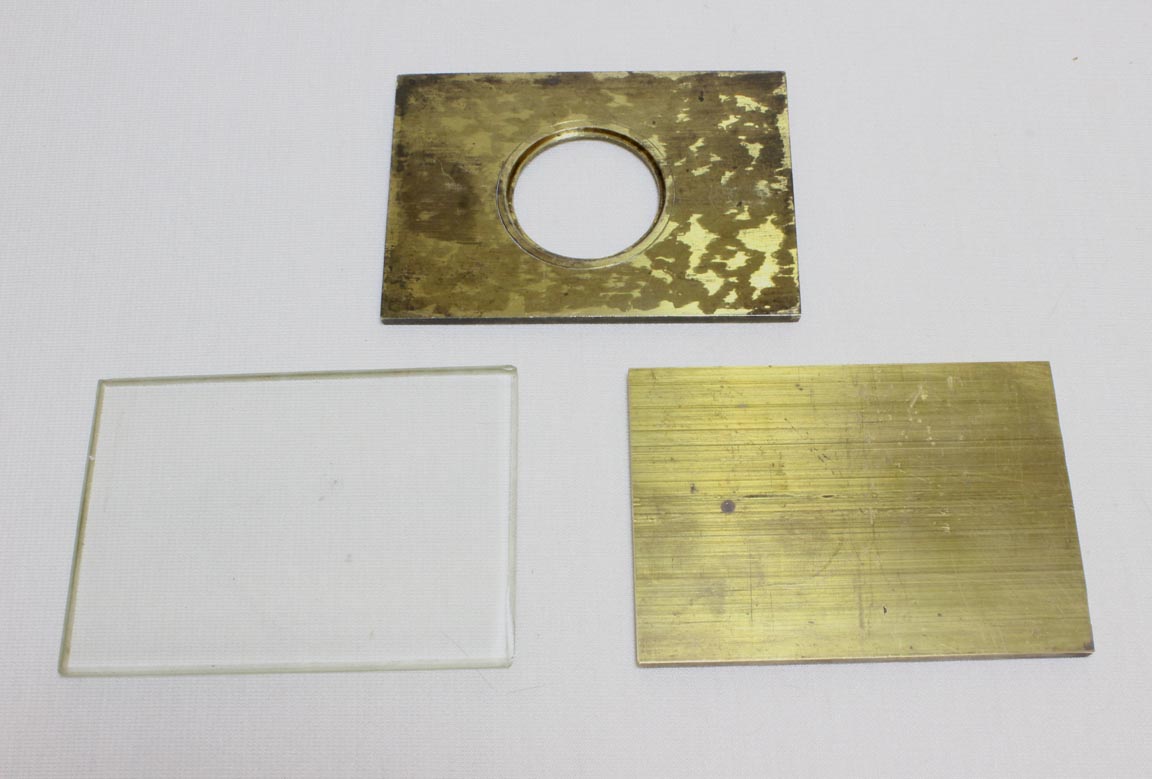
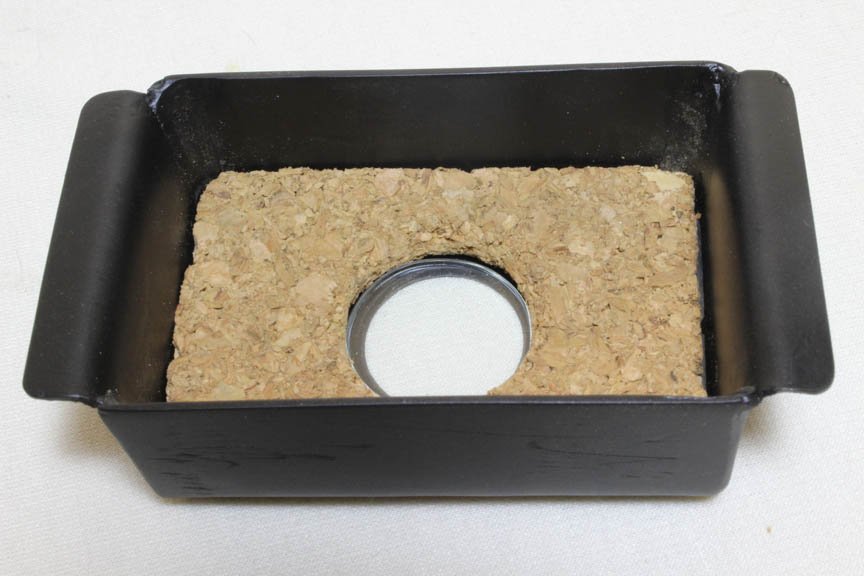
 Four stage inserts were originally supplied. These stage inserts, shown to the left, are present of which two are original and two are accurate and realistic reproductions. The third is a modern replacement of the slide warming table insert. The fourth stage insert is a dissecting trough. Thanks to the courtesy of Mr Thomas Hopkins of the Museum of the History of Science at Oxford, who provided accurate measurements and other information about the original example of the trough (part of the RMS collection), I was able to produce an accurate replica of the dissecting trough. Just as the original, it is made of bent and soldered zinc, with a cork-lined bottom, and is painted flat black (except for the cork). It has a 1 inch diameter glass center in the bottom as well.
Four stage inserts were originally supplied. These stage inserts, shown to the left, are present of which two are original and two are accurate and realistic reproductions. The third is a modern replacement of the slide warming table insert. The fourth stage insert is a dissecting trough. Thanks to the courtesy of Mr Thomas Hopkins of the Museum of the History of Science at Oxford, who provided accurate measurements and other information about the original example of the trough (part of the RMS collection), I was able to produce an accurate replica of the dissecting trough. Just as the original, it is made of bent and soldered zinc, with a cork-lined bottom, and is painted flat black (except for the cork). It has a 1 inch diameter glass center in the bottom as well. ...consists of flat pieces of cork of various degrees of thickness, that are covered over on their undersurface with sheet-lead of sufficient weight to make them sink in fluid.... This accessory would not be needed with the cork-lined bottom of the trough now with the instrument, and apparently supplied to some examples of the instrument.
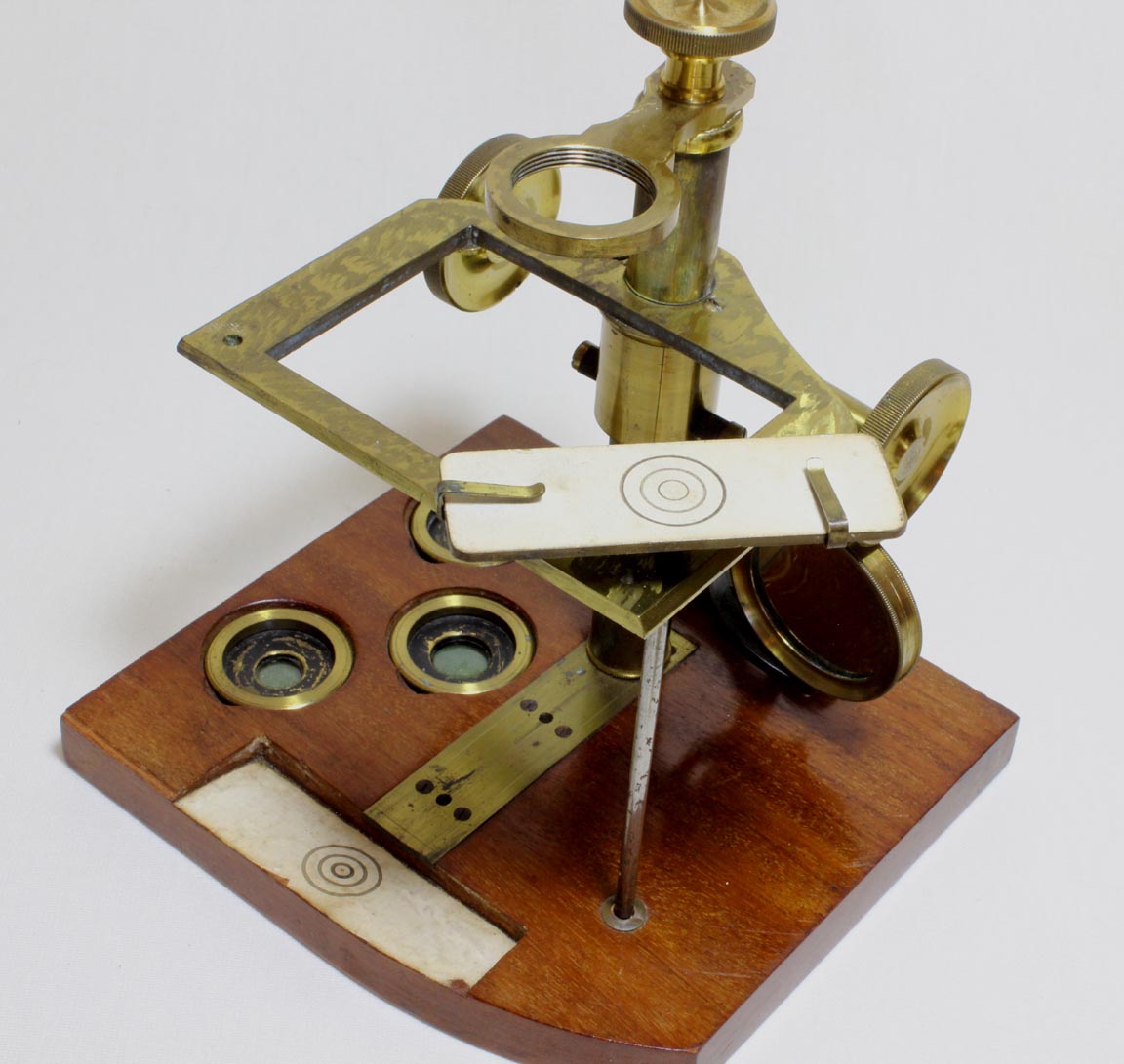 A slide-ringing table, in the form of a brass plate just slightly larger than a standard slide is present. It has a central target, and inserts through the main stage. This plate is affixed to a pointed steel rod on its underside which fits through the hole in the brass stage to register on a brass bearing in the baseboard allowing the ringing table to spin easily.
A slide-ringing table, in the form of a brass plate just slightly larger than a standard slide is present. It has a central target, and inserts through the main stage. This plate is affixed to a pointed steel rod on its underside which fits through the hole in the brass stage to register on a brass bearing in the baseboard allowing the ringing table to spin easily. 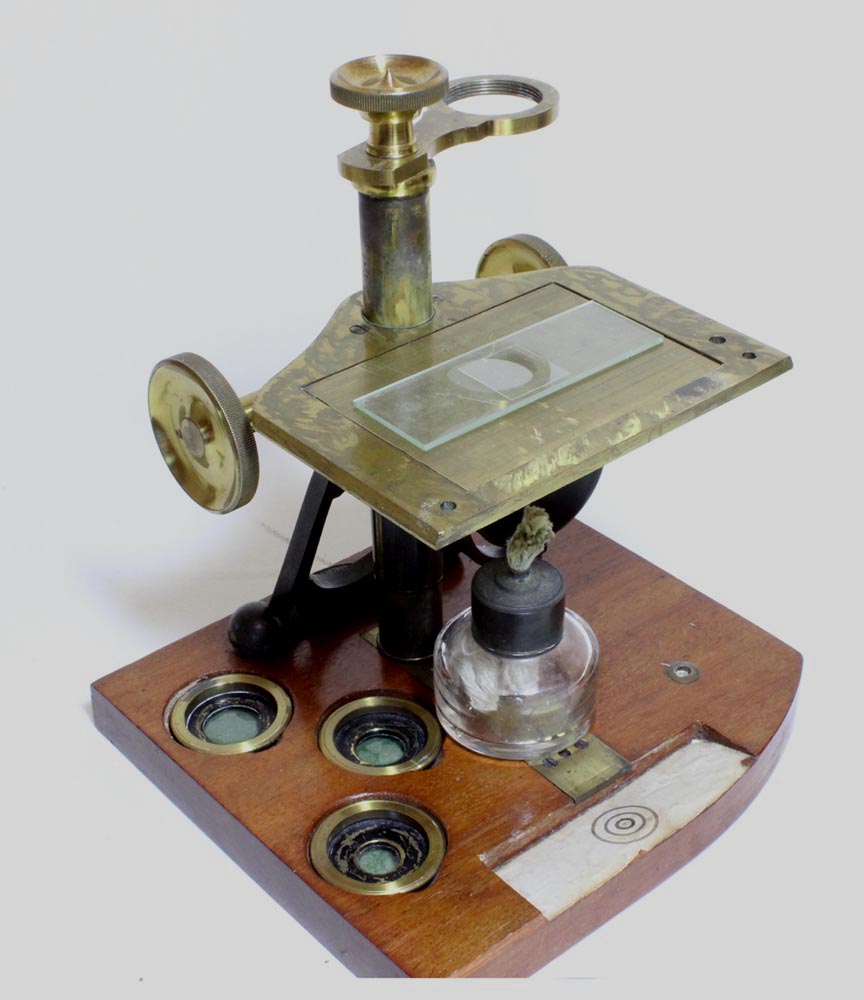 As noted above one of the stage inserts is a solid brass plate, that was meant to serve as a slide-warming table. As in the original, the stage inserts make contact only with the screw heads at the corners. When the warming table is in use, the microscope is erected in the vertical position and the arm of the microscope, as well as the mirror are turned aside. With the mirror aside, the alcohol lamp sits beneath the warming table to heat the slide.
As noted above one of the stage inserts is a solid brass plate, that was meant to serve as a slide-warming table. As in the original, the stage inserts make contact only with the screw heads at the corners. When the warming table is in use, the microscope is erected in the vertical position and the arm of the microscope, as well as the mirror are turned aside. With the mirror aside, the alcohol lamp sits beneath the warming table to heat the slide. 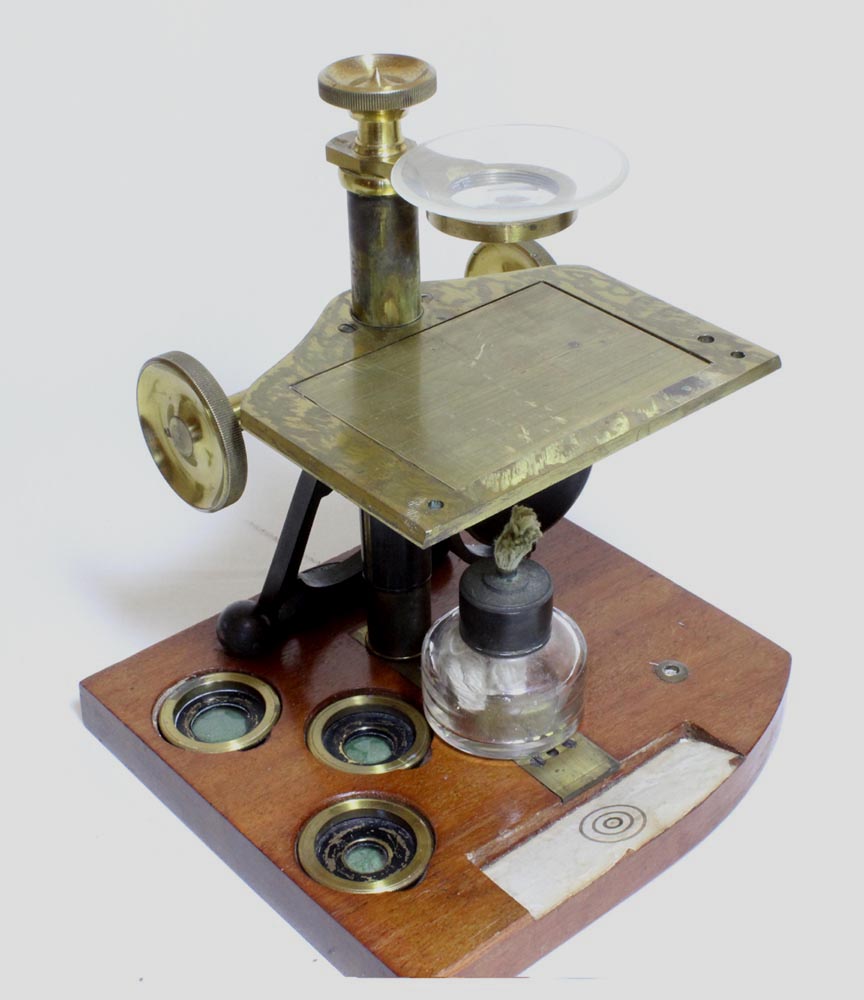 At the same time, or separately if desired, the arm can be turned into the usual position, and a watch glass can be placed on the arm and gently warmed above the table; this allows evaporation of solutions from which crystals are formed for study under the microscope later.
At the same time, or separately if desired, the arm can be turned into the usual position, and a watch glass can be placed on the arm and gently warmed above the table; this allows evaporation of solutions from which crystals are formed for study under the microscope later. 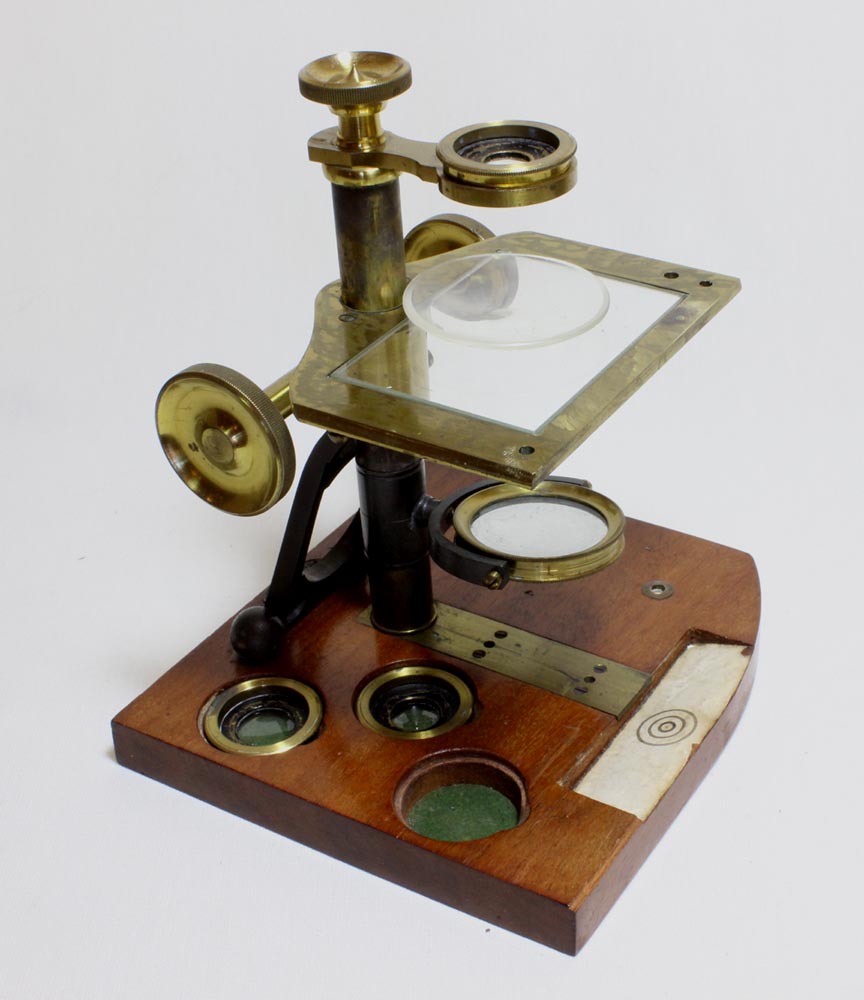 With the glass stage in place a large subject can be studied or dissected, or the watch glasses, which have flattened bottom centers, can be used for study of subjects in a liquid such as is pictured here with one of the simple lenses in place. Parenthetically, the regular brass stage insert could also hold a watch glass in its central aperture.
With the glass stage in place a large subject can be studied or dissected, or the watch glasses, which have flattened bottom centers, can be used for study of subjects in a liquid such as is pictured here with one of the simple lenses in place. Parenthetically, the regular brass stage insert could also hold a watch glass in its central aperture. 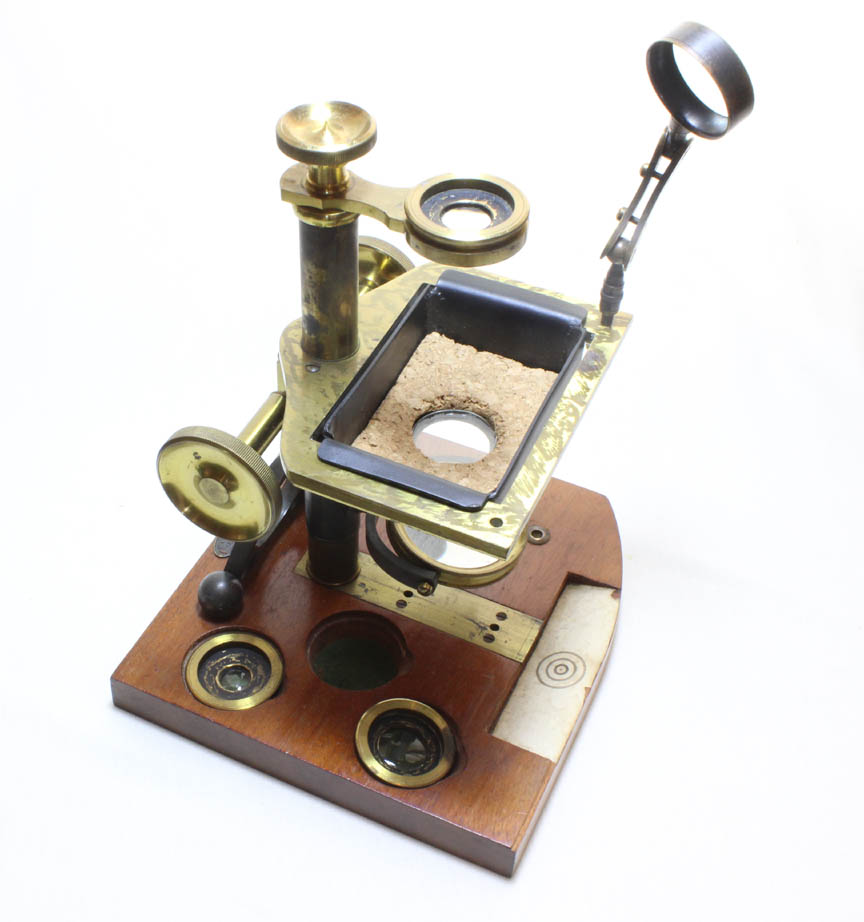 Another interesting stage insert is the 'dissecting trough.' Although this is a replica, it is made of the same materials and with the same techniques as the original. It is copied from the original example in the Museum of the History of Science, Oxford. It is made of single piece of sheet zinc, with a cutout in the center of the bottom covered by glass. This is surrounded by a cork lining of the bottom. The sides are bent up and the edges soldered. It was designed to accomodate a 1 x 3 inch slide. An additional small
Another interesting stage insert is the 'dissecting trough.' Although this is a replica, it is made of the same materials and with the same techniques as the original. It is copied from the original example in the Museum of the History of Science, Oxford. It is made of single piece of sheet zinc, with a cutout in the center of the bottom covered by glass. This is surrounded by a cork lining of the bottom. The sides are bent up and the edges soldered. It was designed to accomodate a 1 x 3 inch slide. An additional small loaded corkwas apparently supplied with some examples of this instrument. This is a small round cork weighed down by lead attached to the bottom which could be placed anywhere in the trough. The trough with the instrument now would not require this since it has a cork-lined bottom.
 The hole in the arm can also be used to support the bottles and a small funnel when refilling the bottles of chemicals. Lastly, the arm can serve as a wrist rest when dropping glue or asphalte-varnish onto the ringing table.
The hole in the arm can also be used to support the bottles and a small funnel when refilling the bottles of chemicals. Lastly, the arm can serve as a wrist rest when dropping glue or asphalte-varnish onto the ringing table.